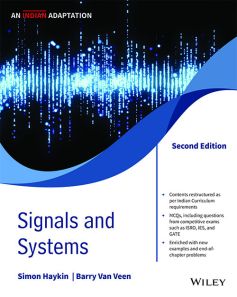Signals and Systems, 2ed, An Indian Adaptation
ISBN: 9789354243158
812 pages
Publication Year: 2021
For more information write to us at: acadmktg@wiley.com

Description
Signals and Systems is a well-established textbook, suitable for an undergraduate level course on signals and systems for students in electronics and communication, electrical and electronics, and computer science engineering programs. The book introduces the concepts of signals and systems, classification and operations on signals, and then focuses on system analysis using Fourier analysis, and Laplace and z-transforms. It then concentrates on the aspects that are most relevant for applications such as communication systems, design of filters, and control systems.
- CHAPTER 1 Introduction
1.1 What Is a Signal?
1.2 Classification of Signals
1.3 Basic Operations on Signals
1.4 Elementary Signals
1.5 What Is a Signal?
1.6 Overview of Specific Systems
1.7 Systems Viewed as Interconnections of Operations
1.8 Properties of Systems
1.9 Noise
1.10 Theme Examples
1.11 Exploring Concepts with MATLAB
1.12 Summary
CHAPTER 2 Time-Domain Representations of Linear Time-Invariant Systems
2.1 Introduction
2.2 The Convolution Sum
2.3 Convolution Sum Evaluation Procedure
2.4 The Convolution Integral
2.5 Convolution Integral Evaluation Procedure
2.6 Interconnections of LTI Systems
2.7 Relations between LTI System Properties and the Impulse Response
2.8 Step Response
2.9 Differential and Difference Equation Representations of LTI Systems
2.10 Solving Differential and Difference Equations
2.11 Characteristics of Systems Described by Differential and Difference Equations
2.12 Block Diagram Representations
2.13 State-Variable Descriptions of LTI Systems
2.14 Exploring Concepts with MATLAB
2.15 Summary
CHAPTER 3 Fourier Representations of Signals and Linear Time-Invariant Systems
3.1 Introduction
3.2 Complex Sinusoids and Frequency Response of LTI Systems
3.3 Fourier Representations for Four Classes of Signals
3.4 Discrete-Time Periodic Signals: The Discrete-Time Fourier Series
3.5 Continuous-Time Periodic Signals: The Fourier Series
3.6 Discrete-Time Nonperiodic Signals: The Discrete-Time Fourier Transform
3.7 Continuous-Time Nonperiodic Signals: The Fourier Transform
3.8 Properties of Fourier Representations
3.9Finding Inverse Fourier Transforms by Using Partial-Fraction Expansions
3.10 Parseval Relationships
3.11 Time–Bandwidth Product
3.12 Duality
3.13 Exploring Concepts with MATLAB
3.14 Summary
CHAPTER 4 Applications of Fourier Representations to Mixed Signal Classes
4.1 Introduction
4.2 Fourier Transform Representations of Periodic Signals
4.3 Convolution and Multiplication with Mixtures of Periodic and Nonperiodic Signals
4.4 Fourier Transform Representation of Discrete-Time Signals
4.5 Sampling
4.6 Reconstruction of Continuous-Time Signals from Samples
4.7 Discrete-Time Processing of Continuous-Time Signals
4.8 Fourier Series Representations of Finite-Duration Nonperiodic Signals
4.9 The Discrete-Time Fourier Series Approximation to the Fourier Transform
4.10 Efficient Algorithms for Evaluating the DTFS
4.11 Exploring Concepts with MATLAB
4.12 Summary
CHAPTER 5 Laplace Transform
5.1 Introduction
5.2 The Laplace Transform
5.3 The Unilateral Laplace Transform
5.4 Properties of the Unilateral Laplace Transform
5.5 Inversion of the Unilateral Laplace Transform
5.6 Solving Differential Equations with Initial Conditions
5.7 Laplace Transform Methods in Circuit Analysis
5.8 Properties of the Bilateral Laplace Transform
5.9 Properties of the Region of Convergence
5.10 Inversion of the Bilateral Laplace Transform
5.11 The Transfer Function
5.12 Causality and Stability
5.13 Determining the Frequency Response from Poles and Zeros
5.14 Exploring Concepts with MATLAB
5.15 Summary
CHAPTER 6 Z-Transform
6.1 Introduction
6.2 The z-Transform
6.3 Properties of the Region of Convergence
6.4 Properties of the z-Transform
6.5 Inversion of the z-Transform
6.6 The Transfer Function
6.7 Causality and Stability
6.8 Determining the Frequency Response from Poles and Zeros
6.9 Computational Structures for Implementing Discrete-Time LTI Systems
6.10 The Unilateral z-Transform
6.11 Exploring Concepts with MATLAB
67.12 Summary
CHAPTER 7 Application to Communication Systems
7.1 Introduction
7.2 Types of Modulation
7.3 Benefits of Modulation
7.4 Full Amplitude Modulation
7.5 Double Sideband-Suppressed Carrier Modulation
7.6 Quadrature-Carrier Multiplexing
7.7 Other Variants of Amplitude Modulation
7.8 Pulse-Amplitude Modulation
7.9 Multiplexing
7.10 Phase and Group Delays
7.11 Exploring Concepts with MATLAB
7.12 Summary
CHAPTER 8 Application to Filters and Equalizers
8.1 Introduction
8.2 Conditions for Distortionless Transmission
8.3 Ideal Low-Pass Filters
8.4 Design of Filters
8.5 Approximating Functions
8.6 Frequency Transformations
8.7 Passive Filters
8.8 Digital Filters
8.9 FIR Digital Filters
8.10 IIR Digital Filters
8.11 Linear Distortion
8.12 Equalization
8.13 Exploring Concepts with MATLAB
8.14 Summary
CHAPTER 9 Application to Linear Feedback Systems
9.1 Introduction
9.2 What Is Feedback?
9.3 Basic Feedback Concepts
9.4 Sensitivity Analysis
9.5 Effect of Feedback on Disturbance or Noise
9.6 Distortion Analysis
9.7 Summarizing Remarks on Feedback
9.8 Operational Amplifiers
9.9 Control Systems
9.10 Transient Response of Low-Order Systems
9.11 The Stability Problem
9.12 Routh–Hurwitz Criterion
9.13 Root Locus Method
9.14 Nyquist Stability Criterion
9.15 Bode Diagram
9.16 Sampled-Data Systems
9.17 Exploring Concepts with MATLAB
9.18 Summary
APPENDIX A Selected Mathematical Identities
A.1 Trigonometry
A.2 Complex Numbers
A.3 Geometric Series
A.4 Definite Integrals
A.5 Matrices
APPENDIX B Partial-Fraction Expansions
B.1 Partial-Fraction Expansions of Continuous-Time Representations
B.2 Partial-Fraction Expansions of Discrete-Time Representation
APPENDIX C Tables of Fourier Representations and Properties
C.1 Basic Discrete-Time Fourier Series Pairs
C.2 Basic Fourier Series Pairs
C.3 Basic Discrete-Time Fourier Transform Pairs
C.4 Basic Fourier Transform Pairs
C.5 Fourier Transform Pairs for Periodic Signals
C.6 Discrete-Time Fourier Transform Pairs for Periodic Signals
C.7 Properties of Fourier Representations
C.8 Relating the Four Fourier Representations
C.9 Sampling and Aliasing Relationships
APPENDIX D Tables of Laplace Transforms and Properties
D.1 Basic Laplace Transforms
D.2 Laplace Transform Properties
APPENDIX E Tables of z-Tansforms and Properties
E.1 Basic z-Transforms
E.2 z-Transform Properties
APPENDIX F Introduction to MATLAB
F.1 Basic Arithmetic Rules
F.2 Variables and Variable Names
F.3 Vectors and Matrices
F.4 Plotting in MATLAB
F.5 M-files
F.6 Additional Help
INDEX

